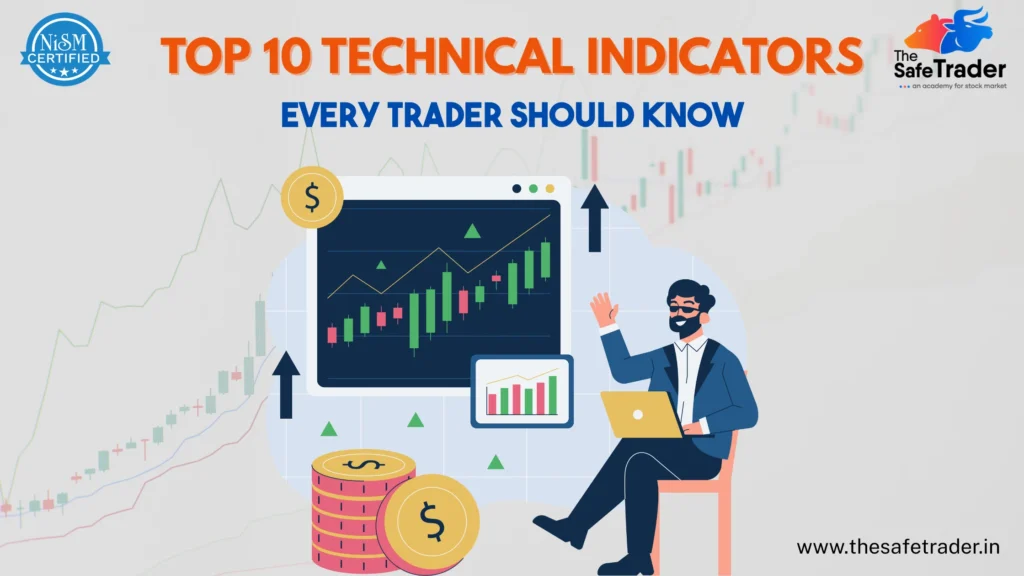
In the world of trading, technical indicators serve as powerful tools to analyze price action, identify trends, and time entries and exits. Whether you’re trading stocks, forex, or cryptocurrencies, indicators provide a structured approach to interpreting market data.
The article aims to explain technical indicators, what makes them useful; with advantages and limitations; and also the top 10 indicators every trader should know.
What Are Technical Indicators?
Technical indicators are mathematical calculations derived from price, volume, or open interest. They are primarily shown as visual overlays or charts that appear alongside the price of a given security. Traders use them to observe trends, reversals, momentum, and time their entry and exit.
These indicators are an essential part of technical analysis, which considers historical price and volume data, rather than earnings or news type fundamental data.
Why Do Traders Use Indicators?
Identifying Trends: To ascertain whether the market is moving upward, downward, or is going sideways.
Reversals: When a trend is about to exhaust itself or change direction.
Confirming signals: To validate price patterns or breakouts.
Entry and exit: Time indicators for entry and exit.
Manage risk: Determine the volatility to set stop-loss accordingly.
Advantages and Disadvantages of Technical Indicators
Advantages
- Simplifies complex market data
- Helps remove emotional bias
- Enables faster decision-making
- Useful in both trending and ranging markets
- Easily customizable and back testable
Disadvantages
- Lagging indicators react after the move starts
- False signals can lead to losses
- Over-reliance can ignore important fundamental or macroeconomic factors
- Not always accurate in highly volatile or manipulated markets
- Requires proper understanding to use effectively
1. Moving Averages (MA)
Category: Trend-Following
What it does:
Moving Averages eliminate the volatile behavior of past prices to offer the trend attitudinal direction over a specified time frame.
Types:
Simple Moving Average (SMA): Takes all closing prices throughout a given time period and divides by the number of time periods.
Example: A 10-day SMA = Sum of last 10 closing prices ÷ 10
Exponential Moving Average (EMA): EMA works the same way as the SMA with one difference: it puts more weight on recent prices, making it more sensitive to price changes.
Common Uses:
- Trend Identification: Whenever price is mostly above MA, then the trend is going up.
- Crossover Signals:
- Golden Cross: When a short-term moving average (e.g., 50-day) crosses above a long-term moving average (e.g., 200-day) → Bullish.
- Death Cross : When short-term moving average crosses below long-term moving average → Bearish.
Strengths:
- Easy to use
- Useful while trending
Limitations:
- Lagged indicator (reacts after price has moved)
- Gives false signals in ranging markets
2. Relative Strength Index (RSI)
Category: Momentum Oscillator
What it does:
RSI estimates the magnitude of recent price changes to assess whether a stock is overbought or oversold.
Formula:
RSI = 100 – [100 / (1 + RS)]
Where RS = Average gain during the last N periods / Average loss during the last N periods (generally 14)
Interpretation:
- Price above 70: Overbought → Price must reverse down
- Price below 30: Oversold → Price must reverse up
- Divergence: When price makes a new high and RSI does not, it is a bearish divergence.
Strengths:
- Identifies potential reversal areas
- Good for swing trading
Limitations:
- During a strong trend, an instrument can stay overbought/oversold for a significant period
- Should be combined with other indicators (such as MACD or trendlines)
3. Moving Average Convergence Divergence (MACD)
Category: Trend + Momentum
What it does:
It measures the difference between two EMAs, usually the 12-period and the 26-period, and has a signal line, which is a 9-EMA of the MACD, so that buy or sell signals can be generated.
Components:
- MACD Line = 12-EMA – 26-EMA
- Signal Line = 9-EMA of the MACD line
- Histogram = MACD Line – Signal Line (Visual presentation of momentum)
Key Signals:
- MACD Synthesis: Crossing of the MACD line above or below the Signal line signifies respective buy or sell.
- Zero Line Crossover: When the MACD Line crosses the baseline, trend confirmation ensues.
Strengths:
- One indicator combining trend and momentum
- Able to detect trend reversals and divergences
Limitations:
- Lagging nature
- False signals sometimes in choppy markets
4. Bollinger Bands
Category: Volatility
What it does:
Bollinger Bands comprise a middle band (20-period SMA) and two outer bands, usually set at ±2 standard deviations, signaling the level of market volatility.
Interpretation:
- Price near upper band → Overbought
- Price near lower band → Oversold
- Bollinger Squeeze/Contraction of bands → Low volatility precedent to a breakout
- Breakout: Price closes out of the bands → Possibly new trend coming into play
Strengths:
- Perfect for spotting volatility and breakouts
- Helps to identify the overbought/oversold state
Limitations:
- Doesn’t consider the direction of the breakout
- False signals under low volumes
5. Stochastic Oscillator
Category: Momentum
What it does:
Compares a stock’s closing price with its range in the past time period—mostly 14 days.
Formula:

Interpretation:
- Above 80: Overbought
- Below 20: Oversold
- Crossovers: %K crossing %D can signal a trend shift
- Divergences signal weakening trends
Strengths:
- Reversals can be identified
- Short-term trading responsive
Limitations:
- Would give false signals during strong trends
- Best used in range-bound markets
6. Volume
Category: Confirmation tools
What Is It?
Volume measures the shares/contracts that have been traded during the defined time period.
Why It Is Important:
- The moves in prices are confirmed by the volume.
- Price + High Volume = Strong Move
- Price + Low Volume = Weak/False Move
- Breakouts with heavy volume tend to last longer
Related Tools:
- On-Balance Volume (OBV): Cumulative indicator of volume
- Volume Profile: Volume’s distribution at various levels of price
Strengths:
- Volume gives a real-time indication of strength behind moves
- Must be taken into account while validating a trend or breakout
Limitations:
- Raw volume is not predictive
- Volume patterns vary across asset classes
7. Average True Range (ATR)
Category: Volatility
What it is:
The ATR is a measurement of market volatility that calculates the average range of price a security has traded during the past set time period, most commonly 14 days.
Formula:
True Range = Maximum of: (High – Low)
- |High – Previous Close|
- |Low – Previous Close|
ATR = 14-period moving average of True Range
Utilization Cases:
- Setting stop losses based on distance
- To alter positions’ sizes
- For identifying periods that are volatile and those that are stable
Strengths:
- Dynamic in terms of managing risk
- Works on every sort of asset
Disadvantages:
- Does not provide a direction with respect to price
- It is best to have trend indicators with it
8. Fibonacci Retracement
Category: Support/Resistance
What it does:
The retracement uses key Fibonacci ratios (23.6%, 38.2%, 50%, 61.8%, and 78.6%) to predict possible support or resistance areas.
How to Use:
- Find the swing high and swing low
- Put the retracement levels on the price chart
- Observe how the price reacts near these levels
Application:
- They can be used to project pullbacks during trends
- Use them with a particular candlestick pattern or RSI/MACD for confirming signals
Strengths:
- Strongly respected by traders
- Easy and intuitive
Limitations:
- It is subjective (depends on swing points chosen)
- Often proposes multiple possible levels, so confirmation is required
9. Parabolic SAR (Stop and Reverse)
Category: Trend-Following
What it does:
Plots dots on the price chart to mark potential trend reversals and act as trailing stop-losses.
Interpretation:
- When dots are below the price: Bullish trend
- When dots are above the price: Bearish trend
- When dots flip from being above the price to below and vice versa: Trend reversal
Strategy:
- Trail the stop-loss with SAR
- Use SAR in conjunction with another indicator like MACD or RSI for better confirmation
Strengths:
- Clear visualization for trend reversals
- Best suited for determining stop-loss points
Limitations:
- Can be whipsawed in choppy sideways markets
- Rent that price best trending markets
10. Ichimoku Cloud
Category: Multi-functional (Trend, Momentum, Support/Resistance)
Function:
Gives a comprehensive view of market sentiment and trend direction with five components.
Components:
- Tenkan-sen (Conversion Line): Short-term trend
- Kijun-sen (Base Line): Medium-term trend
- Senkou Span A & B (Kumo/Cloud): Future support/resistance
- Chikou Span (Lagging Line): Confirms trend
Interpretation:
- Price above cloud → Bullish
- Price below cloud → Bearish
- Cloud color: Bullish (green) or Bearish (red)
Strengths:
- Multiple data points have been provided in one single window
- Best for swing and long-term traders
Limitations:
- Complicated for beginners
- May lag during fast-moving markets
Can You Rely on Indicators to Make Profits?
Yes — but with caveats.
Indicators do not have the ability to foresee and tell you about the future. Instead, these indicators tell you about the last hour, day, month, or year, the market volumes, highs, lows, collars, open interest, prices, trends, and many more to help you make an informed decision. If you’re a successful trader, you’d never rely on one single indicator. Instead, you apply many indicators, look for confirmation, combine them with price action, risk management, and analysis of market context.
Indicators work best when:
– Two or more indicators are used in confluence (agree)
– Clear rules for risk management are established to accompany them
– Back tested and tailored to fit the trader’s framework
Yet one must avoid extremes in reliance. For in reality, there is no single indicator that is correct in every condition ever faced by an active market. Hence, trading surely boils down to strategy and discipline and adaptability with the existing conditions and not merely technical signals.
Final Thoughts
Technical indicators are important market analysis tools but clearly not in the realm of certainty. Knowing how each indicator works, measuring factors, and when to use it is the main pillar of the trade strategy building. Those top 10 indicators should be a solid building block with which further trade strategy building or refining can continue.
Pro Tip: Pick 2 or 3 indicators that go well together, test them on historical data, then build your system from there with confidence!
Want to Know More Details, Please Click Here

